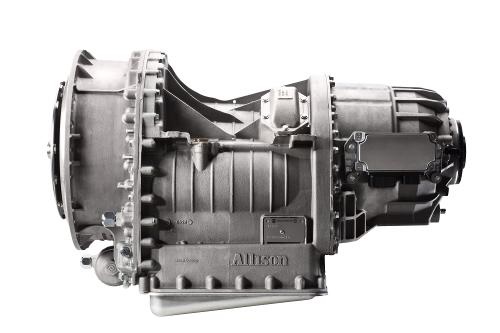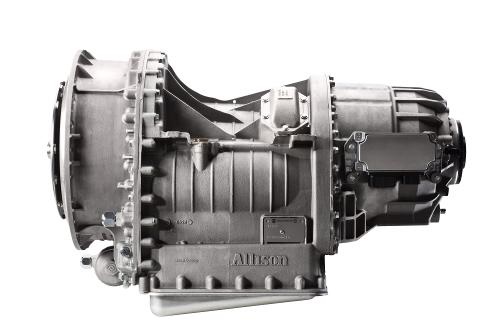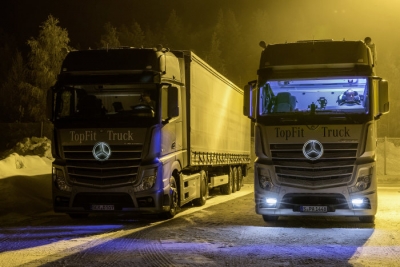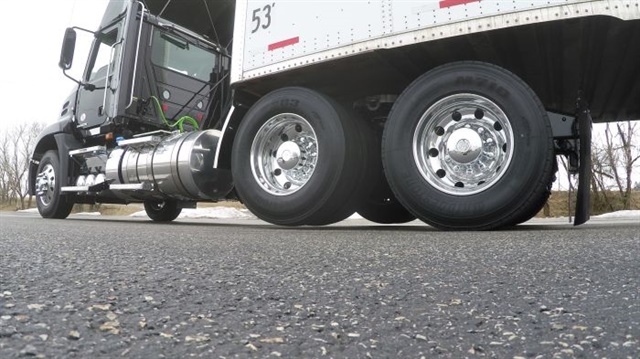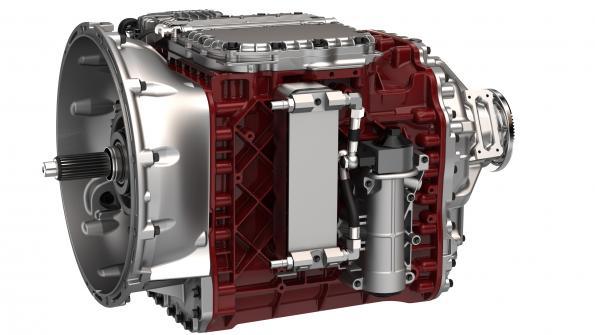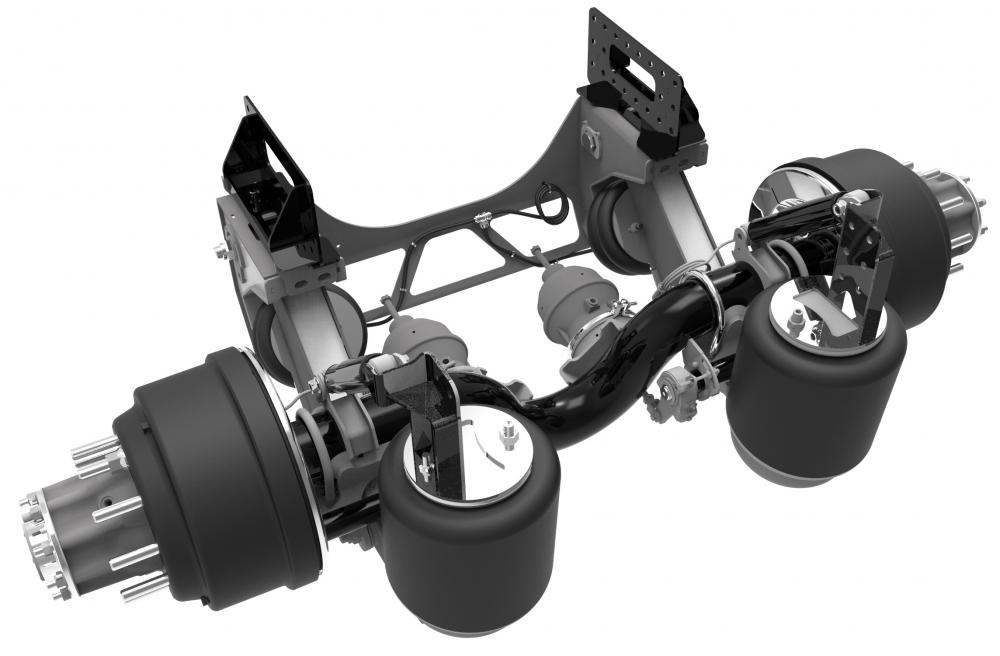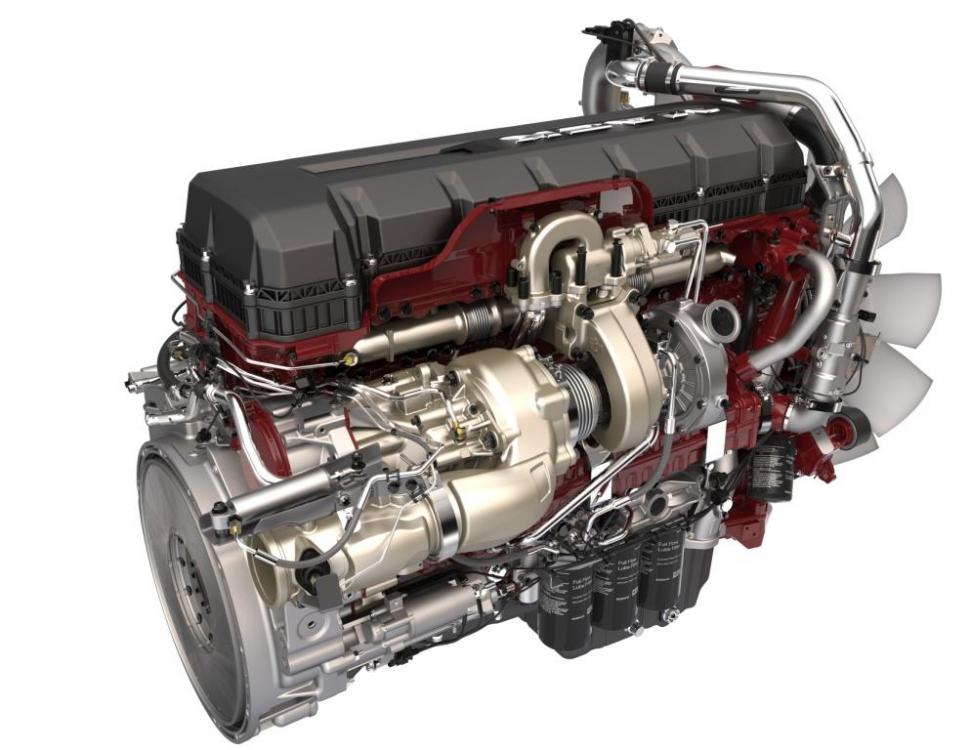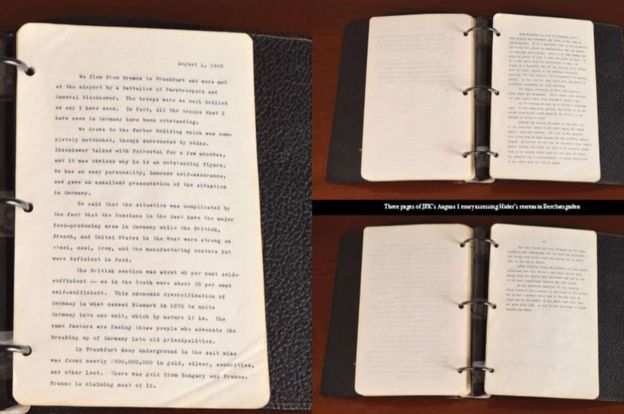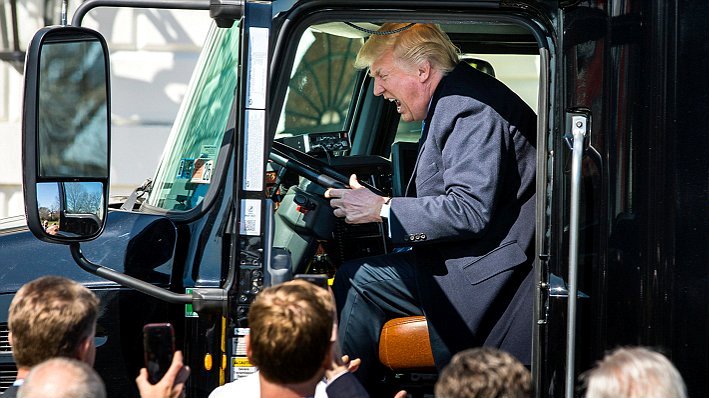
kscarbel2
Moderator-
Posts
18,886 -
Joined
-
Days Won
114
Content Type
Profiles
Forums
Gallery
Events
Blogs
BMT Wiki
Collections
Store
Everything posted by kscarbel2
-
-
Cummins Westport near-zero NOx rating viewed as game-changer
kscarbel2 replied to kscarbel2's topic in Trucking News
Fleet Now Operating Zero-Emissions Natural Gas Engine Heavy Duty Trucking / March 23, 2017 Total Transportation Services, Inc. (TTSI), a drayage trucking company in the ports of Los Angeles and Long Beach, Calif., has begun using one of the first Cummins Westport (CWI) ISX12 G low-NOx natural gas engines for its trucking operations. Available for order later this year, the 12.0L engine’s emissions will be certified by the California Air Resources Board (CARB) to produce 90% less NOx than the current EPA standard for heavy-duty engines, and are equivalent to that of a truck powered by electricity from the electrical grid. “The trucking industry is facing hard choices on how we are going to reduce our emissions impact, especially here in Southern California,” said Victor La Rosa, CEO and President of TTSI. “We believe the quickest and most affordable way to cut our NOx emissions to essentially zero is with the new CWI engine and renewable natural gas (RNG). We’ve successfully operated natural gas trucks in the San Pedro, Calif., ports since the last Clean Trucks program in 2008, and it’s great that we now have a dramatically improved engine and an even cleaner fuel with renewable natural gas.” In 2016, Cummins Westport began full production of the 8.9L ISL G low-NOx engine and has shipped engines to bus and refuse truck OEMs. The ISX12 G low-NOx engine is based on the 12.0L ISX12 G first introduced in 2012 and will start production early next year. CWI anticipates a large demand for this heavy-duty alternative-fuel truck engine. South Coast Air Quality Management District and the California Energy Commission supported Cummins Westport by providing development funding, recognizing the importance of this technology in helping California reduce emissions from heavy-duty trucks. About one-third of California residents live in communities with pollution that exceeds federal standards, according to estimates by CARB. -
Truck News / March 23, 2017 Recognizing some of its customers weren’t yet ready to transition to the new CK-4 and FA-4 heavy-duty engine oil categories introduced in December, Chevron has opted to continue offering CJ-4 in addition to its new category oils. “Initially, going into it, a lot of people expected there would be a mandatory conversion to CK-4 or FA-4 and that hasn’t been the case,” Rommel Atienza, commercial brand manager for Chevron in North America told Truck News in an interview at the Mid-America Trucking Show. “To that point, we still have a 15W-40 CJ-4 product available in the market today. That decision was made when we started to hear about the direction OEMs were going and the hesitation some of our customers had in that conversion. They really wanted to see the benefits of CK-4 and FA-4 products before they made that transition.” Meanwhile, Chevron is continuing its educational outreach to inform customers about the benefits of the new category oils. “We are finding we still have to continue that work from an education standpoint,” Atienza said. “It’s amazing how many people still have no idea what is going on with that particular transition. People still have a lot to learn around the category change.” Atienza said Chevron is the only major oil company to continue producing and selling CJ-4 product. Fleets will still have to transition to the new oils as they add new tractors, but extending the use of CJ-4 allows them to defer the 3-5% upcharge for the new oils. “Some of the folks really evaluated their fleets and whether or not they needed to make that transition at this time, and since it wasn’t mandatory, decided they would stay with CJ-4 for the time being,” said Atienza. “We’re seeing that as an advantage in some cases, where these customers who have older equipment feel they aren’t ready to make that transition and we have that opportunity to keep them on CJ-4 product until they’re ready to make that move.” Atienza said Chevron hasn’t yet decided when it will discontinue production of CJ-4. Better performing CK-4 and FA-4 oils hit the market in December 2016. They are required to handle hotter temperatures generated by the latest-generation, low-emission engines. While Chevron has chosen to continue offering both categories, Atienza added it’s not because it doesn’t believe in the benefits of the new categories. “We’ve done some preliminary teardowns and the data looks really good,” Atienza said of the new category oils. “We are seeing the oxidation stability protection that the new spec’ calls for and we’re seeing a lot less deposits on the pistons. And the oil, at the end of the day, is lasting longer. We are really happy with the results we’ve seen so far.” While the transition to CK-4 is underway, the adoption of FA-4 – a low-viscosity oil designed to provide further fuel savings through lower high-temperature high-shear properties – has been slow. Only Detroit has announced it’s factory filling with FA-4 and Atienza acknowledged the lack of support for fuel economy category came as a surprise. “There has been a much slower transition and we are not expecting a lot of people to move to that this year,” he said. “I think they’re still trying to understand what the benefits are and there just isn’t the demand for it right now. We’re going to keep our eyes on that; we will see what the OEMs do.” Chevron plans to continue its educational campaign around the new category oils. But it also wants customers to know they don’t have to make the switch if they’re running older equipment and want to continue using CJ-4. “I think right now, the biggest misconception we’re seeing is, people think there aren’t any other options available,” said Atienza. “When we tell them we still have CJ-4 product available it’s a surprise to a lot of these folks because most other oil companies have made that full transition.” Of course continuing to offer CJ-4 also means there’s one more product in the marketplace that customers will have to be sure not to put into new equipment. Atienza said its CJ-4 oil retains its traditional packaging while CK-4 and FA-4 are both clearly labelled as such. “That helps our customers reduce the risk of using the wrong product,” he said. Related reading - https://www.bigmacktrucks.com/topic/49214-ford-offers-ck-4-alternative-oil-for-super-duty-diesels/
-
Navistar Expands OnCommand Connect Capabilities Heavy Duty Trucking / March 23, 2017 Navistar unveiled three new OnCommand Connect Telematics offerings at the Mid-America Truck Show today, including its new, OnCommand Connection Telematics. The new system supports all makes and models of Class 6 through 8 vehicles, provided they are equipped weight a J1939 or J1708 diagnostic port. This new system integrates and interprets vehicle health information from multiple telematics sources in an integrated approach with a user-friendly interface. The system is designed to give owner-operators and small fleets the same telematics-enabled diagnostic powers that big fleets enjoy. OnCommand Connection Marketplace is a new, open-architecture, cloud-based, technology platform for a broad range of driver support tools. The first app supported by this system is the OnCommand Electronic Driver Log (ELD) which automates Federal Hours of Service compliance requirements mandated for all carriers by Dec. 18, 2017. Other tools, such as driver inspection reports, will become available later. OnCommand Connection Telematics, OnCommand Connection Marketplace and the Electronic Driver Log app will be available mid-summer at International Truck dealerships, select retail locations and online.
-
Allison TC10 Available for Kenworth, Peterbilt Trucks Later this Year Heavy Duty Trucking / March 23, 2017 Allison Transmissions has announced that its TC10 transmission will be available from Paccar later this year in the Kenworth T680 and T880, and Peterbilt 567 and 579 truck models. The fully automatic TC10 combines Allison’s torque converter with a twin countershaft gear scheme. The company said this combination provides both full power shifts and cruising fuel economy for greater productivity and efficiency. The transmission is well-suited for distribution applications in which the tractor-trailer splits its work cycle between city and highway conditions. "The TC10 combines the startability and continuous, uninterrupted power shifting qualities of a fully automatic transmission with the cruising aspects of a manual transmission," said Heidi Schutte, Allison’s vice president of marketing and sales for the Americas. “Simply put, drivers don’t have to be experts at shifting because the TC10 shifts for them at exactly the right point to maintain vehicle performance and maximize fuel economy, thereby allowing the driver to focus their attention on the road.” Fleets adopting the TC10 and sharing data with Allison are reporting an average fuel economy improvement of 5% when compared to other transmission technologies. With FuelSense technology, a unique package of software and electronic controls, the TC10 is designed to achieve the best fuel economy in most situations, according to Allison. The Allison TC10 includes a standard warranty of five years or 750,000 miles, with no exclusions on individual components and no scheduled maintenance for 500,000 miles. .
-
Allison TC10 Available for Kenworth, Peterbilt Trucks Later this Year Heavy Duty Trucking / March 23, 2017 Allison Transmissions has announced that its TC10 transmission will be available from Paccar later this year in the Kenworth T680 and T880, and Peterbilt 567 and 579 truck models. The fully automatic TC10 combines Allison’s torque converter with a twin countershaft gear scheme. The company said this combination provides both full power shifts and cruising fuel economy for greater productivity and efficiency. The transmission is well-suited for distribution applications in which the tractor-trailer splits its work cycle between city and highway conditions. "The TC10 combines the startability and continuous, uninterrupted power shifting qualities of a fully automatic transmission with the cruising aspects of a manual transmission," said Heidi Schutte, Allison’s vice president of marketing and sales for the Americas. “Simply put, drivers don’t have to be experts at shifting because the TC10 shifts for them at exactly the right point to maintain vehicle performance and maximize fuel economy, thereby allowing the driver to focus their attention on the road.” Fleets adopting the TC10 and sharing data with Allison are reporting an average fuel economy improvement of 5% when compared to other transmission technologies. With FuelSense technology, a unique package of software and electronic controls, the TC10 is designed to achieve the best fuel economy in most situations, according to Allison. The Allison TC10 includes a standard warranty of five years or 750,000 miles, with no exclusions on individual components and no scheduled maintenance for 500,000 miles. .
-
A group of Daimler AG researchers have been observing the effects of artificial daylight on the mental state and performance of truck drivers in a series of experiments set in the Polar Circle’s winter darkness. Siegfried Rothe, project manager and head of Daimler’s experiment works with Daimler to help improve living conditions for truck drivers, subsequently improving the image of the occupation. Rothe determined due to the shape of most truck cabs, only a comparatively low percentage of natural daylight reaches a truck driver’s light receptors, and sparked the idea for the experiment. Eight Daimler test drivers participated in what would be two typical working weeks for truckers at the site in Rovaniemi, Finland. Alternating between one week in a truck cab with conventional lighting and another week with a “Daylight+” module which supplied additional daylight while driving and during breaks, the truckers were observed and compared to only themselves.The drivers were examined for performance changes when they were exposed to additional biologically effective daylight under clearly defined conditions. The additional light was distributed in three different intensities. Steady light while driving, whereby the intensity was adjusted to the exterior light level. An intense light shower of maximum intensity during the tests before and after driving. Light while reclined, likewise of maximum intensity, during breaks while the driver relaxes in their seat, which has been positioned for a power nap. After the two-week experiment concluded, the drivers were individually interviewed. Having both spent time in the Arctic Circle during the darkest time of the year, Daimler test truck drivers, Richard Schneider and Philippe Strasser both expressed enthusiasm for Daylight+. In addition, the drivers from the experiment consistently reported their perception of space in the cab to be considerably more pleasant with the article daylight system. "When designing the series of tests, we hadn't even considered that the space might appear larger," said Rothe. According to Rothe, it will take several months to analyse the data from the series of experiments in the Arctic Circle. “Only then we will be able to make a recommendation as to whether the test findings should advisably lead to changes in the design of cab lighting.” .
-
Latest Mack innovations target fuel efficiency
kscarbel2 replied to kscarbel2's topic in Trucking News
Mack Adds Automatic Standby to 6x2 Liftable Pusher Axle Heavy Duty Trucking / March 23, 2017 Mack Trucks has added an Automatic Standby Mode option for its 6x2 liftable pusher axle available on Pinnacle highway models, the company announced here at the Mid-America Trucking Show. Macks aid that with Automatic Standby Mode, drivers no longer need to manually activate standby mode, which simplifies operation. The 6x2 with liftable pusher axle offers improved fuel efficiency and productivity and is designed for applications that haul out heavy and return empty. Mack has also added rear air disc brakes as an option to its 6x2 liftable pusher axle. When the ignition is off, Automatic Standby equalizes the suspension pressure, preventing the rear axle from being overloaded. The drive doesn’t need to initiate standby or remember to the button sequence to put it into standby. The 6x2 with liftable pusher axle is capable of determining payload by using sensors in the rear suspension and either lifting or lowering the foremost rear axle. When an empty load is detected, the axle lifts, allowing the tractor to operate as a 4x2 for less drag, better fuel efficiency and reduced tire wear, which helps lower maintenance costs. For full loads, the same axle is lowered to provide additional stability and distribution of the trailer’s weight. “The Mack Pinnacle 6x2 with liftable pusher axle model really helps those customers in bulk haul applications save on fuel because sensors lift or lower the axle to decrease or increase traction, providing better performance and ride,” said Roy Horton, Mack director of product strategy. “The addition of Automatic Standby Mode further simplifies things for the driver by eliminating any need for manual input in putting the truck in standby mode to prevent overload.” . -
Latest Mack innovations target fuel efficiency
kscarbel2 replied to kscarbel2's topic in Trucking News
Mack Ups Fuel Efficiency with Super Econodyne Direct Option Heavy Duty Trucking / March 23, 2017 Mack Trucks introduced Super Econodyne Direct, a new fuel-saving option that combines the Super Econodyne engine rating with a direct-drive version of its mDrive automated manual transmission. here at the Mid-America Trucking Show. “Our Super Econodyne rating was previously only available with the overdrive version of the mDrive, but the recent release of numerically lower rear axle ratios allows us to use the direct drive variant,” said Scott Barraclough, Mack technology product manager. “The result is up to 1% better fuel efficiency on top of the 3% Super Econodyne already delivered on its own.” In addition to a higher top gear ratio, the direct drive mDrive is more efficient because it features reduced parasitic losses. This results from torque not transmitted to the direct drive mDrive’s countershaft while in top gear. Instead, the transmission's input and output shafts are essentially locked together, according to Mack. Super Econodyne Direct is best suited for applications of 80,000 pounds GCW or less where drivers remain in top gear for a large percentage of the time. It also works best on mostly flat terrain and when drivers remain mostly in constant speed. Mack’s Super Econodyne rating fully integrates Mack MP engines and the Mack mDrive to deliver fuel savings. The integrated powertrain enables lower engine cruise RPM to save fuel, without impacting power or performance. Super Econodyne-rated Mack engines cruise at approximately 1,150 rpm, a reduction of 200-300 rpm from a typical highway cruise rpm, which results in up to 3% improved fuel efficiency. Super Econodyne ratings are available for the 11-liter Mack MP7 and 13-liter MP8 engines. Mack also announced that its 2017 MP8 engine with turbo compounding is now available for order. The turbo compounding system gives the engine an improved operating range and holds the top gear when cresting a hill, even with the engine rpm decreasing. Available exclusively with Mack’s Super Econodyne downspeeding package, the MP8 with turbo compounding converts wasted energy from the exhaust into mechanical energy that is fed back to the engine. The system adds up to 50 additional horsepower, improving fuel efficiency by up to 8.8%, according to Mack. The additional power generated by the turbo compounding system allows the engine to maintain full torque as low as 900 rpm. -
Sean Kilcarr, Fleet Owner / March 23, 2017 The demand for better fuel economy is still there, but GM says the desire for more “functionality” is what’s driving work truck design efforts now. John Schwegman will tell that while demand for greater fuel economy “has always been important and will stay that way” for light- and medium-duty units “work truck” roles, the desire now is for more options and more overall “functionality” when it comes to vocational-focused platforms. Schwegman, U.S. director of commercial product and medium duty for the General Motors fleet division, explained to Fleet Owner during an interview at the 2017 NTEA Work Truck Show, that the focus on the segment is now turning to delivering more focused products to “fill up the series of niches” in the work truck space. “These fleets don’t want a lot of frills but they do want functionality,” he stressed. “They don’t want leather interiors or chrome but they do want safety features such as collision mitigation and automatic emergency braking (AEB) systems. There is a definite trend towards a willingness to pay for them.” As a result, he said Chevrolet is crafting mid-level and base-level packages that incorporate such safety technology. “They’ve become very popular [systems] across the work truck buyer spectrum; we’ve heard that loud and clear,” Schwegman noted. Yet “functionality” also revolves around getting more vocational truck options as well, he emphasized – especially when it comes to powertrains. That’s one reason why GM went into partnership with Navistar to build a new Class 4-5 conventional commercial truck due to launch next year, he said – one that will be offered with GM’s Duramax diesel engine mated to an Allison Transmission automatic gearbox by the second half of 2018. “This is another opportunity to bring higher fuel efficiency together with more performance in this segment,” Schwegman pointed out. “It offers the low-end torque the work truck side of the business wants and is also 100% rated to run on B20 biodiesel fuel.” GM is also moving to offer more “hardened” engines in this space as well that can run on 100% compress natural gas (CNG) or propane or on some “bi-fuel” mixture of CNG and gasoline if desire. On another front, GM’s recent introduction of a Class 6 low cab forward model – the 6500XD – expands its lineup of cabover Class 3-5 medium-duty trucks built in partnership with Isuzu Commercial Truck. The key to the 6500 XD is it’s just under 26,000 lbs., so it doesn’t require a commercial driver’s license to operate. “Now we will have models across the work truck spectrum: pickups, vans, medium-duty conventionals and cabovers,” Schwegman explained. “Now our customers can go to one dealer, one OEM, for all of their work truck needs. It allows them to ‘hit the easy button’ where their truck needs are concerned.” Having both medium-duty conventional and cabover or “tilt cab” models on hand also fulfills the “functionality” role, too, as each brings specific performance advantages to the work truck table. Schwegman said sales of “tilt cabs” track around 20,000 to 25,000 units per year, with 80% of them focused on pickup and delivery operations in metropolitan markets where turning radius is vital. “Our low cab forward trucks have an incredibly tight turning radius; one equal to a Chevy Sonic,” which is one of Chevrolet’s most compact of cars, he pointed out. But conventional models, which see sales of 50,000 to 60,000 units annually, offer higher ground clearance in both on- and off-road operation and are a better fit for more rough-and-tumble work for landscapers, utility fleets, and in the oil fields. The final piece of “functionality” revolves around communication links and truck telematics. Again, Schwegman sees a “divergence” among buyers as to what level of communication and vehicle data analysis they desire, but the demand for it is there among all of them. “We’ve got OnStar available across 98% of our platforms; it’s embedded into the vehicles for customers to use if they so choose,” he said. “So what we’re doing now is developing ‘cheaper’ communication packages for crash notification, emergency response, and route monitoring – that gives fleets an ‘easy button’ for basic services,” Schwegman explained. “But for those that want to dive deeper into telematics and data analysis customized to a particular fleet, we offer services through our partners Telogis and Spireon,” he said. “The whole point is this: it’s built in, so if you want it, it’s there; you don’t need to buy a system and install it. But if you don’t want it, no worries; you don’t have to use it.”
-
Fleet Owner / March 23, 2017 Emphasizing the brand’s “tradition of application excellence” and customer-focused innovation, Mack Trucks used its media slot at the 2017 Mid-America Trucking Show Thursday to introduce three new products aimed at improved fuel efficiency. The Super Econodyne Direct is a new fuel-saving option that combines Mack’s Super Econodyne concept with a direct drive version of the Mack mDRIVE automated manual transmission (AMT) to boost fuel efficiency by up to 1 percent. The result is up to 1 percent better fuel efficiency on top of the 3 percent Super Econodyne already delivered on its own, according to the company. Despite a numerically higher top gear ratio, the direct drive mDRIVE is inherently more fuel efficient thanks to reduced parasitic losses, explained Roy Horton, Mack director of product strategy. This is due to the fact that torque is not transmitted to the direct drive mDRIVE’s countershaft while in top gear. Instead, the transmission’s input and output shafts are essentially locked together. Super Econodyne Direct is best suited for applications of 80,000 lbs. GCW or less where drivers remain in top gear for a large percentage of time. It also works best on mostly flat terrain and when drivers remain mostly in constant speed. Mack’s Super Econodyne rating fully integrates Mack MP engines and the Mack mDRIVE to deliver significant fuel savings. The integrated powertrain enables lower engine cruise RPM to save fuel, without impacting power or performance. Super Econodyne-rated Mack engines cruise at approximately 1,150 rpm, a reduction of 200-300 rpm from a typical highway cruise rpm. Super Econodyne ratings are available with both the 11-liter Mack MP7 and 13-liter Mack MP8 engines. In other news, Mack Trucks has rolled out Automatic Standby Mode, an innovation for its 6x2 liftable pusher axle available on Mack Pinnacle highway models. The 6x2 with liftable pusher axle offers improved fuel efficiency and productivity benefits and is designed for applications that haul out heavy and return empty, such as bulk haul. The addition of Automatic Standby Mode eliminates the need for the driver to manually push buttons to initiate standby mode, simplifying operation. Mack has also added rear air disc brakes as an option to it 6X2 liftable pusher offer. “The Mack Pinnacle 6x2 with liftable pusher axle model really helps those customers in bulk haul applications save on fuel because sensors lift or lower the axle to decrease or increase traction, providing better performance and ride,” said Horton. “The addition of Automatic Standby Mode further simplifies things for the driver by eliminating any need for manual input in putting the truck in standby mode to prevent overload.” When the ignition is off, Automatic Standby equalizes the suspension pressure, preventing the rear axle from being overloaded. The driver does not have to remember to initiate the standby mode and also does not need to remember the button sequence to put it in standby. The 6x2 with liftable pusher axle monitors trailer weight and adjusts the truck’s driveline configuration to boost fuel efficiency without impacting performance. The 6x2 with liftable pusher axle is capable of determining payload by using sensors in the rear suspension and either lifting or lowering the foremost rear axle. When an empty load is detected, the axle lifts, allowing the tractor to operate as a 4x2 for less drag, better fuel efficiency and reduced tire wear, which helps lower maintenance costs. For full loads, the same axle is lowered to provide additional stability and distribution of the trailer’s weight. The company also announced that the 2017 Mack MP8 engine with turbo compounding is now available for order, offering highway customers increased fuel efficiency. “The new MP8 engine with turbo compounding is just one of the many engine upgrades Mack made to further enhance fuel efficiency for customers,” said Roy Horton, Mack director of product strategy. “The turbo compounding system enables an improved operating range and allows a truck to hold top gear when cresting a hill, even with the engine rpm decreasing.” Available exclusively with Mack’s Super Econodyne downspeeding package, the MP8 with turbo compounding converts wasted energy from the exhaust into mechanical energy that is fed back to the engine. The system adds up to 50 additional horsepower, improving fuel efficiency by up to 8.8 percent. The additional power generated by the turbo compounding system allows the engine to maintain full torque as low as 900 rpm. .
-
Peterbilt Expands Next Generation Chassis Routing Trailer/Body Builders / March 23, 2017 Peterbilt implemented its engineered routings in all configurations of the Models 579 and 567 as well as in the iconic Model 389, further enhancing serviceability across its product lines. “Thanks to the innovative features of the engineered chassis routings, Peterbilt customers will enjoy enhanced ease of repair and maintenance,” said Scott Newhouse, Peterbilt Chief Engineer. “Peterbilt has taken great strides to improve product quality with the implementation of the engineered routings, which provide consistent manufacturability, improved product quality and improved serviceability.” The engineered routings bundle each system (air, fuel and electrical) separately, allowing easier identification and service by technicians. Routing enhancements are standard with orders specifying 2017 emissions engines.
-
Ford sees lower 2017 profits with most of the hit in Q1 Automotive News/Reuters / March 23, 2017 Citing front-loaded product launch costs and engineering expenses, Ford Motor Co. said that much of the year-over-year decline it expects from its 2017 financial performance will occur in the first quarter. Ford said Thursday it expects a full-year pretax profit of $9 billion, down from $10.4 billion it made in 2016 as it invests in autonomous cars and new mobility services. The automaker expects earnings per share of between 30 cents to 35 cents in the first quarter, down from the same period last year and lower than analyst expectations. “The first quarter is where the year-over-year declines come,” CFO Bob Shanks told analysts in a Thursday morning event. The company initially filed its disclosure with the Securities and Exchange Commission. Shanks said Ford will be dealing with increased commodity costs and a warranty expense that he declined to give details about. He also said the automaker will be affected by vehicle volumes as demand for new cars and light trucks cools. He said the company’s U.S. vehicle stocks (79 days supply in February) are in good shape, but “don’t be surprised” if Ford temporarily shuts down lines at U.S. assembly plants in the near future to cut back production. Much of the product-launch costs Shanks described are related to the Ford Super Duty and Lincoln Continental, which debuted near the end of last year. Ford maintained its pretax profit forecast it originally issued in January for its Ford Credit arm of about $1.5 billion thanks to lower U.S. auction values. Ford Credit posted a $1.9 billion pretax profit in 2016, down $207 million from 2015. Ford shares were down less than 1 percent to $11.69 a share as of early Thursday afternoon. 2018 improvement Ford still expects that its 2018 financials will rise, and be higher than the $10.4 billion it earned in 2016. It expects that rise will come thanks to increases in its core business, Shanks said. "We think we can do more with trucks, we think we can do more with utility vehicles, we can do more with performance and we've got plans in place to do that," he said. In a Thursday client note, Buckingham Research Group analyst Joseph Amaturo said “we believe Ford's announcement today is the initial confirmation of our investment thesis that pricing is deteriorating in North America and in select international markets, particularly China.” Mobility investments The 2017 profit dip comes as the automaker invests heavily in what it calls “emerging opportunities” as it develops autonomous vehicles and expands into mobility services such as ride sharing and bicycle sharing. Last month, Ford announced it would invest $1 billion over the next five years in artificial intelligence startup Argo AI to help build the brains of its robot cars. Ford last year also purchased Silicon Valley-based shuttle service Chariot. Ford recently said Chariot would expand to eight cities by the end of 2017, including a city outside the U.S. Last March, the automaker created a Smart Mobility subsidiary to invest in emerging mobility opportunities as it targets more services outside traditional car and truck ownership. Executives have said they expect profit margins of up to 20 percent on the new services. 'Nobody knows anything' Shanks on Thursday said Ford is well-positioned on some of President Donald Trump’s pending policy decisions, although “in terms of policy, nobody knows anything.” He said the automaker would be closely watching the vote on the GOP’s proposed healthcare bill, since the outcome could have an impact on what issues the president tackles next. Shanks said that any import tariff on Mexico-built vehicles would be a “drag on our business,” but noted that Ford is in better shape than some of its competitors, since its profit-generating trucks and SUVs are all built in the U.S. Shanks praised Trump’s decision last week to re-open a midterm review of vehicle emissions standards, but noted that Ford isn’t asking for a rollback. “Whatever happens, we still have to improve,” Shanks said, citing global emissions mandates. “We’ll still be investing in electrified propulsion, better and better internal combustion engines and light-weighting. That’s the reality of the business.”
-
Everyone has different situations. I carefully choose a vehicle which I'm absolutely enamored with, and then keep it for 20 years or more. So for me, I want to and actually enjoy maintaining that investment, a vehicle whose exterior, interior, performance and functionality are all 10's for me. Owning the vehicle since new, I "know" the maintenance has always been performed. I know the vehicle. In contrast, in year 2017, so many people are clueless about maintenance, or simply don't wish to do it as they should. I wouldn't want to be on the receiving end of a vehicle they owned. If you're a short time owner, buying late model used to avoid that initial depreciation is a shrewd move.
-
The other side of the story – why tensions exist RT / March 23, 2017 Israeli police officer assaults a Palestinian truck driver in East Jerusalem. The officer is shown head-butting, kicking and slapping a 50-year-old Palestinian truck driver. “I got to work this morning in my truck which is by the Interior Ministry in the Wadi Joz neighborhood, as always,” said the truck driver, Mazen Shwiki, as quoted by the Jerusalem Post. The policeman accused the Palestinian truck driver of hitting his parked car and refused to accept any apologies. "The policeman started to curse me and used derogatory language, and then he butted my head and started hitting me for no reason. All that, even though I admitted that I hit his car," Shwiki recollected. Ahmad al-Tawil, who witnessed the assault, told Ma’an News that said he tried to stop the officer, but was also beaten. There have been other incidents involving excessive violence by Israeli security forces towards Palestinians in East Jerusalem. Recently a Palestinian teen was shot in the chest by Israeli forces at the Shufat camp in occupied East Jerusalem. The forces accused the teen of throwing stones at military vehicles. A nine-year-old girl was seriously injured at the Qalandia checkpoint between the West Bank and East Jerusalem, after she was shot in the foot for carrying a bag in a “suspicious manner.” .
-
I agree with you 500 percent. Purchasing a vehicle is an investment, alike buying a home. Why not maintain one's investment? My vehicles after one or two decades still look virtually new. If you care for the paint from day one, it's a "walk in the park".
-
Once upon a time, we actually enjoyed privacy
kscarbel2 replied to kscarbel2's topic in Odds and Ends
U.S. Senate votes to overturn Obama broadband privacy rules Reuters / March 23, 2017 The U.S. Senate on Thursday voted to repeal regulations requiring internet service providers to do more to protect customers' privacy than websites like Alphabet Inc's Google or Facebook Inc. The vote was along party lines, with 50 Republicans approving the measure and 48 Democrats rejecting it. The two remaining Republicans in the Senate were absent and did not cast a vote. According to the rules approved by the Federal Communications Commission (FCC) in October under then-President Barack Obama, internet providers would need to obtain consumer consent before using precise geolocation, financial information, health information, children's information and web browsing history for advertising and internal marketing. The vote was a victory for internet providers such as AT&T, Comcast and Verizon Communications, which had strongly opposed the rules. The bill next goes to the U.S. House of Representatives. Senate Majority Leader Mitch McConnell said the Senate was overturning a regulation that "makes the internet an uneven playing field, increases complexity, discourages competition, innovation, and infrastructure investment." [Good luck selling that line, Mitch] But Democratic Senator Ed Markey said, "Republicans have just made it easier for American’s sensitive information about their health, finances and families to be used, shared, and sold to the highest bidder without their permission." In a joint statement, Democratic members of the FCC and the Federal Trade Commission said the Senate vote "creates a massive gap in consumer protection law as broadband and cable companies now have no discernible privacy requirements." Republican commissioners said in October that the rules would unfairly give websites like Facebook, Twitter and Google the ability to harvest more data than internet service providers and thus dominate digital advertising. -
Muslim woman pays no mind to the London terror attack, casually walks by a dying man while checking phone. .
-
BBC / March 23, 2017 A diary kept by President John F Kennedy as a young man travelling in Europe, revealing his fascination with Adolf Hitler, is up for auction. Kennedy, then 28, predicted "Hitler will emerge from the hatred that surrounds him now as one of the most significant figures who ever lived". "He had in him the stuff of which legends are made," he continued. Kennedy wrote the entry in the summer of 1945 after touring the German dictator's Bavarian mountain retreat. It is thought by historians to be the only diary every kept by the 35th US president. The original copy will be auctioned for the first time on 26 April in Boston by longtime owner Deirdre Henderson, who worked as a research assistant for Kennedy while he was a US senator with White House ambitions. Kennedy wrote that Hitler "had boundless ambition for his country which rendered him a menace to the peace of the world, but he had a mystery about him in the way he lived and in the manner of his death that will live and grow after him". The 61-page diary was kept by Kennedy around four months after Hitler committed suicide. At the time, the young American was touring Europe as a newspaper reporter after finishing his military service aboard a ship in the Pacific Ocean. Some two decades later Kennedy would address crowds in West Berlin as US president. He gave Ms Henderson the diary in order to inform her of his views on foreign policy and national security, she said. In a description of the auction, she wrote: "When JFK said that Hitler 'had in him the stuff of which legends are made', he was speaking to the mystery surrounding him, not the evil he demonstrated to the world." [her personal opinion – Kennedy’s words speak for themselves] "Nowhere in this diary, or in any of his writings, is there any indication of sympathy for Nazi crimes or cause," she continued. The diary also contains JFK's thoughts about the British election and Winston Churchill, who Ms Henderson called his "idol". The winning bid is expected to be around $200,000 (£160,000). .
-
After climbing into a famous American brand truck today, President Donald Trump was angered to learn that the iconic truckmaker is now foreign-owned. "We're going to make America great again", Trump said. "And we're going to make American brands American again." More news at eleven. .
-
Reel America: "Alaska Highway" - 1944 Preview
kscarbel2 replied to kscarbel2's topic in Odds and Ends
-
(A reasonable summary of current events) Dylan Stableford, Yahoo News / March 22, 2017 President Trump is clinging to his wiretapping claim “like a drunk to an empty gin bottle,” the Wall Street Journal said in a scathing editorial published Tuesday night. And that claim, floating in the president’s “seemingly endless stream of exaggerations, evidence-free accusations, implausible denials and other falsehoods,” is severely damaging his credibility, both at home and abroad. “If President Trump announces that North Korea launched a missile that landed within 100 miles of Hawaii, would most Americans believe him? Would the rest of the world? We’re not sure,” the paper said. The Journal slammed Trump’s evidence-free assertion that former President Barack Obama ordered the wiretapping of Trump Tower before the 2016 presidential election. Trump leveled his explosive charge on Twitter on March 4, and the White House has refused to back down, even after FBI Director James Comey dismissed the allegation as unfounded. “He has offered no evidence for his claim, and a parade of intelligence officials, senior Republicans and Democrats have since said they have seen no such evidence,” the paper’s editorial board wrote. The president has plenty of media critics, and the Journal’s editorial board was not particularly supportive of his candidacy. But the editorial is striking, given the paper’s traditionally conservative tone. Its owner, Rupert Murdoch, also owns Fox News, Trump’s favorite cable news network. “Two months into his presidency, Gallup has Mr. Trump’s approval rating at 39 percent,” the editorial continued. “No doubt Mr. Trump considers that fake news, but if he doesn’t show more respect for the truth, most Americans may conclude he’s a fake President.” The paper also pointed out how Trump’s refusal to back off his evidence-free claim has co-opted what could have been a positive news cycle. “This week should be dominated by the smooth political sailing for Mr. Trump’s Supreme Court nominee and the progress of health-care reform on Capitol Hill,” the editorial said. “These are historic events, and success will show he can deliver on his promises. But instead, the week has been dominated by the news that he was repudiated by his own FBI director.” The Journal wasn’t the only paper to publish a Trump takedown Tuesday. In an op-ed for the Washington Post, former Obama national security adviser Susan Rice warned that false statements from the Trump White House “are part of a disturbing pattern of behavior that poses real and potentially profound dangers to U.S. national security.” “First impressions matter,” she wrote, “and an unsettling pattern has already been established.” “The foundation of the United States’ unrivaled global leadership rests only in part on our military might, the strength of our economy and the power of our ideals,” Rice explained. “It is also grounded in the perception that the United States is steady, rational and fact-based [at least in perception]. To lead effectively, the United States must maintain respect and trust. So, when a White House deliberately dissembles and serially contorts the facts, its actions pose a serious risk to America’s global leadership, among friends and adversaries alike.” Following Comey’s testimony, the New York Times published an op-ed titled “All the President’s Lies.” “The ninth week of Donald Trump’s presidency began with the F.B.I. director calling him a liar,” the Times’ David Leonhardt wrote. “Comey didn’t use the L-word in his congressional testimony Monday. Comey serves at the pleasure of the president, after all. But his meaning was clear as could be.” “I’ve previously argued that not every untruth deserves to be branded with the L-word, because it implies intent and somebody can state an untruth without doing so knowingly,” Leonhardt continued. “But the current president of the United States lies. He lies in ways that no American politician ever has before. He has lied about — among many other things — Obama’s birthplace, John F. Kennedy’s assassination, Sept. 11, the Iraq War, ISIS, NATO, military veterans, Mexican immigrants, Muslim immigrants, anti-Semitic attacks, the unemployment rate, the murder rate, the Electoral College, voter fraud and his groping of women. “He tells so many untruths that it’s time to leave behind the textual parsing over which are unwitting and which are deliberate,” Leonhardt added, “as well as the condescending notion that most of Trump’s supporters enjoy his lies.”
BigMackTrucks.com
BigMackTrucks.com is a support forum for antique, classic and modern Mack Trucks! The forum is owned and maintained by Watt's Truck Center, Inc. an independent, full service Mack dealer. The forums are not affiliated with Mack Trucks, Inc.
Our Vendors and Advertisers
Thank you for your support!


